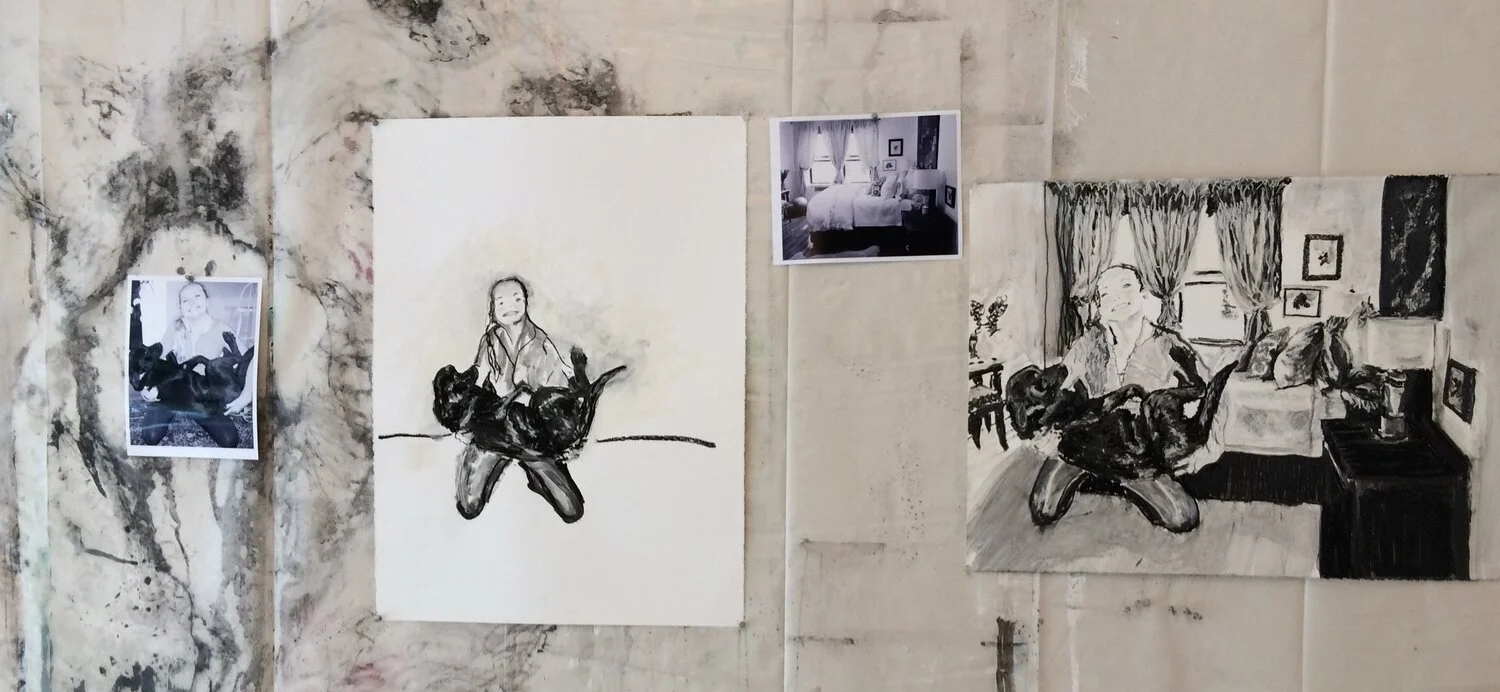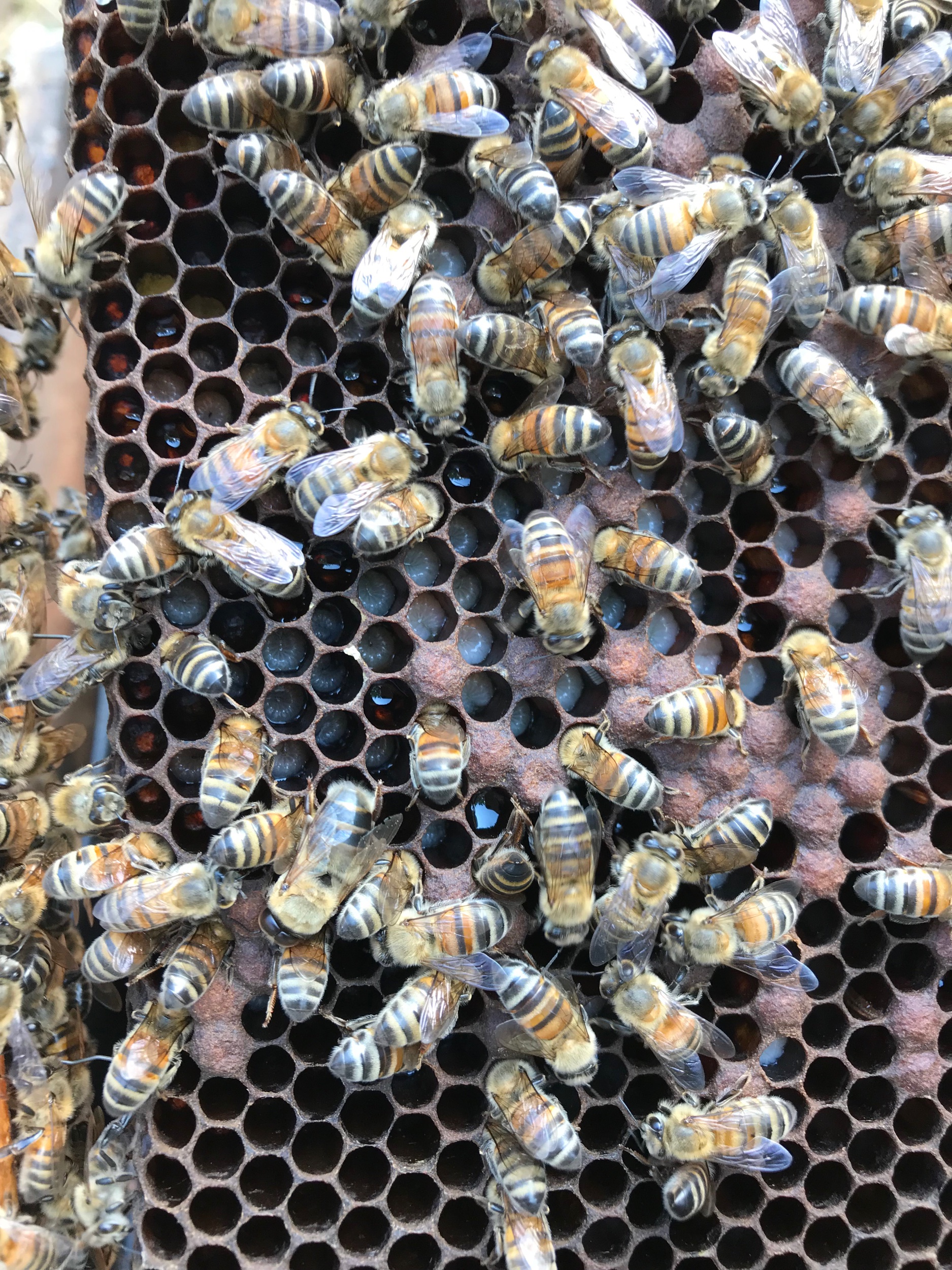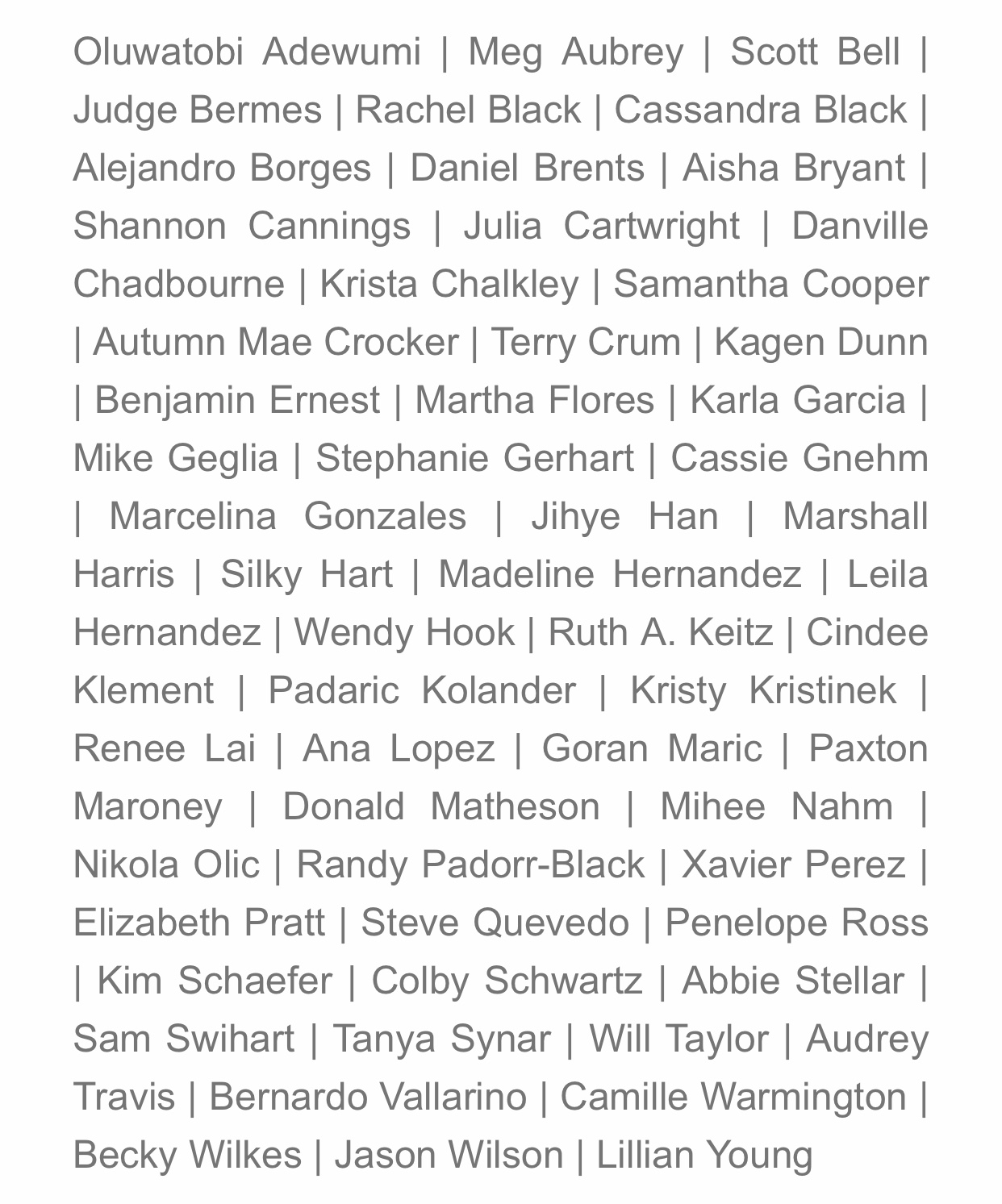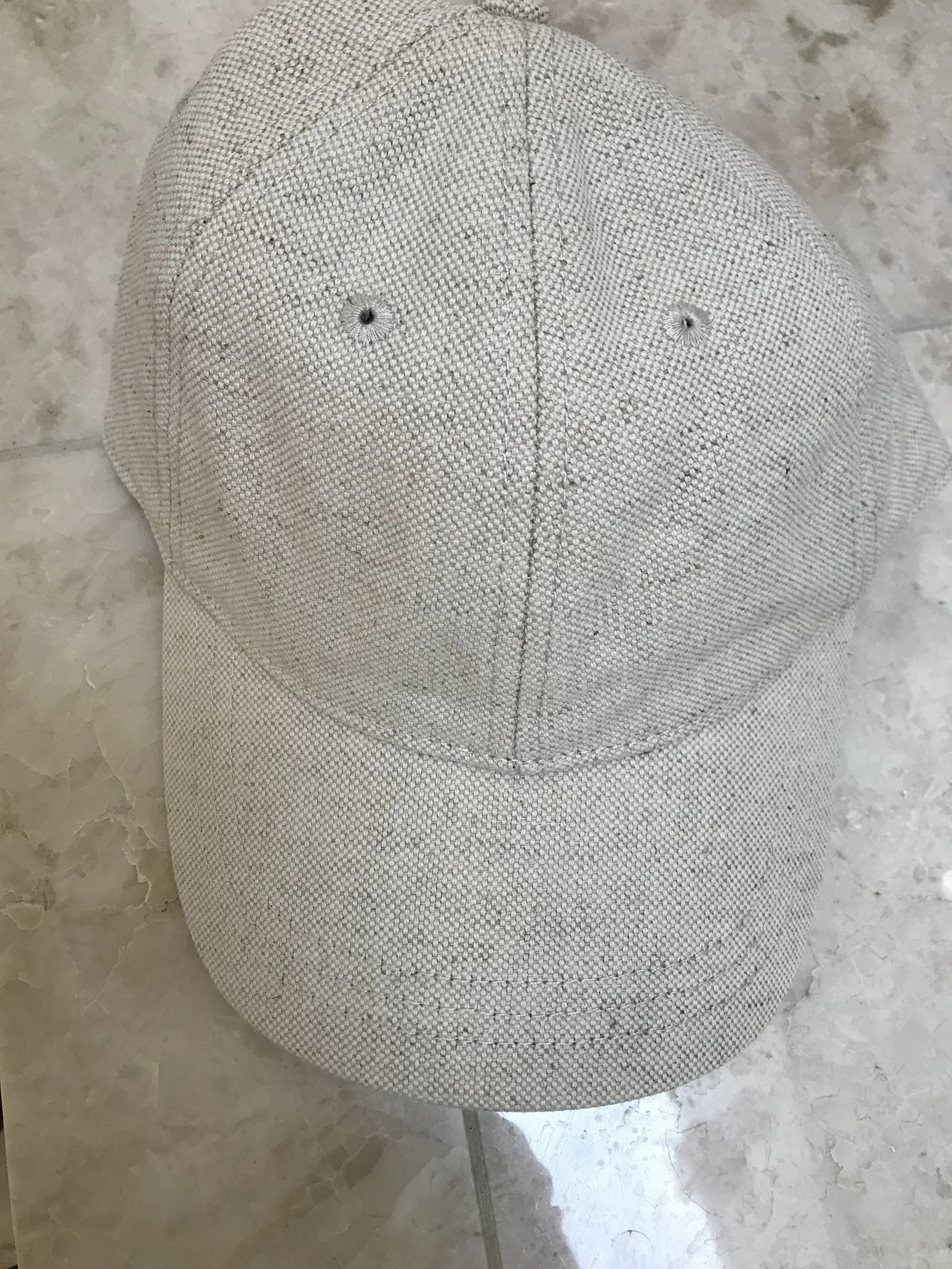Like apples, honey bees were introduced to North America in the 17th Century by the European settlers. Prior to the arrival of the European settler’s honey bee, native insects and bees handled the task of pollination in the new world. In the early 1600´s, the honey bee was brought to North America for honey production and beekeeping became a commercial and profitable occupation.
Bee school birthday gift.
For my 62nd birthday, my son Griffin and daughter-in-law Alex gave me bee school for two at Beeweavers outside of College Station. Below are some photos from the day.
When we got out of the car, immediately we noticed a lovely white noise–the hum of busy bees filled the warm, summer air. I love that sound.
This is Roosevelt (or as Roosevelt would say, it is what is left of Roosevelt). He has been at BeeWeavers since he was 22 years old. Roosevelt is our teacher, guide and bee guru for the day.
You need to wear long sleeves, loose jeans, and closed-toe shoes. They provide the bee nets/hats and jackets. We are posing in front of some bee boxes and trying to let you see the smoke can behind us. Roosevelt really wanted the smoke to show in the picture. You can’t see the smoke.
When you arrive one of the first things you see is this sweet bee bath. I have never noticed bees bathing and drinking water before.
A close up of the bees in the bee bath floating on corks.
Selfie time
These are the boxes they use to show the public. I think they have thousands out and about nearby fields.
Roosevelt is smoking the honey bee boxes before we take a look Inside.. The smoke calms them down.
The bees were not aggressive.
Bees on the outside of the box.
The bees carry on with their work as we inspect the first frame.
The bees secrete a brown wax from their abdomens to close the cells. The yellow in some sells is pollen and the tiny white spec is a larvae. It is all very fascinating. Some cells are empty.
The yellow bag on this bees leg is pollen he has brought back to the hive.the pollen sticks to the long hairs on their legs.
Here is a guy with 2 packs of pollen.
This frame is used to raise queens. They sell 500 queens a day.
A close up of the wax cells the queens are incubated in.
When the queen is ready to mate she is put in a boxe like these. She flies out to mate and returns to the box she came from. Beeweavers queens are not artificially inseminated. I was really glad to hear that.
If you are starting your own honeybee farm you can purchase bees instead or robbing a hive. They will arrive in a box like this. I personally prefer to support local bees.
They put in the bee boxes a piece of cotton like this. The bees do not like it and they try to get it out. Their efforts fluff up the cotton and beetles get trapped in it. It is a great way to get rid of pest without pesticides.
Here is a piece of the cotton and a few trapped beetles.
Here is Roosevelt when he first joined Beeweavers. He Was a great guide and teacher.
This calf was found alone on their farm, they took him in, bottle fed him and named him buzz. I am not sure if he thinks he is a bee or people. He loves to be scratched, who doesn’t?
It was a great day despite the temperature. We learned a lot about honey bees. It was good to see a commercial bee establishment that cares about chemicals, pesticides and natural selection. A birthday gift I will remember for a long time.
Tomato cage sculpture material
I ran to Southland hardware to purchase more wire cloth for my installation and spied some tomato cages. Wondering if they could add to my palette of materials I took home a few to play with.
Tomato cages
Squish, squash, twist, turn, fold, pull, cut repeat
Throw on a rip of charged screen for garnish
Play some more.
I ran out of time today but I feel like it might have some potential.
Bombus and the blueberry
This is a continuation of an earlier post that documented my intuitive process to embrace and abstract the bee that was listed on the endangered species list January 11, 2017.
The posting was titled Embracing Bombus Affinis. Here is one more experiment.
In the experimental piece below I focused on the transparency of the wings.Through the wings you can see the bees hairs on the back of his abdomen. You can also see the flora in the background and through his wings. FYI- a favorite of the Rusty Patch bumble bee is blueberries. Blueberries are one of my favorites too. There is always a box of blueberries in our refrigerator. I hate the thought of my blueberries being pollinated in a lab.
Bombus Affinis VI
30” X 44”
I am not sure if showing the transparency is necessary or if it bogs down the energy with too much information.
If you want to help insure our food remains pollinated as nature intended see below-
Limit the use of pesticides and chemical fertilizers whenever possible or avoid them entirely. Pesticides cause lethal and sublethal effects to bees and other pollinators.
https://www.fws.gov/midwest/endangered/insects/rpbb/factsheetrpbb.html
The ghost print
Private viewing of Hiram Butler Gallery
On July 24th, Alexander Squier https://www.alexandersquier.com/, the head of the the MFAH Glassell Studio School printmaking department, arranged for our printmaking class to get a private viewing of the Hiram Butler Gallery http://hirambutler.com/ print collection. It was a treat! We even got a peak at the cottage at the back of the property. Below are a few pictures from the day. All the work we looked at was exceptional and the Jacob Hashimoto wood Block prints are really something to see. Next time you go ask to see the work in the cottage. FYI- the garden is prime for a planting of pollinator plants and housing a bee condo for bumbles.
I find this tiny piece inspiring, it is giving me bee wing ideas.
Leaving I saw this huge pile of bamboo waiting for the city of Houston’s trash collectors to pick it up. I immediately text Doug Welch to ask for permission to rob it of enough sticks to make done native bumble bee houses.
if I am lucky I can convince Curtis to take this project on. 🤞 I am hyper focused on my installation and completely buzzed to bee.
Josh Pazda was so knowledgeable about the work and so generous with his time. I am never really comfortable in a gallery but Josh is so approachable and interested in what we wanted to see, It was a great gallery experience.
Five eyes
Bees have five eyes. They have three small ocelli eyes on the top of their head, they are simple lenses that discern light intensity. They also have two very large compound eyes that contains about 6,900 facets on the sides of their head. I thought the below monoprint of Bombus Affinis (Rusty Patch) bumblebee did a good job of showing the facets.
Bombus Affinis II compound eye detail.
Bombus Affinis - looking back and comparing
I ran into the print making room to drop off some new paper. I took the opportunity to see how the last 6 compared to each other and how multiple bees might look together. I will do one more experiment and the plan the grouping.
I am really liking these 6 today. I don’t think they are your typical rendering of a bee. Any thoughts? I am glad I took the time to look at these as a group. They are inspiring me to make several different bees from different views in this same technique and showing them together. I am getting some interesting ideas of how to do it.
i will do one more experiment first.
Sewing 🐝 #4 experiment for possible community project.
Sewing 🐝 #4
This piece is a conversation starter. The bee on this cap is the Bombus Affinis or commonly known as the Rusty Patch bumble bee. This bee was listed on the endangered species list in 2017. It is the first U.S. bee to be listed.
Finished piece.
No planing just winging it. It explains why that antenna is so BIG
This fuzzy little body needs some wings.
Detail of wing and legs
I need to delete the giant antennae.
Copy added
Every bee needs some pollen in the air.
After I finished and stood back I was not pleased. It was too busy, too much. Today I took out Impact. It feels better, I will live with it and maybe take out Endangered and the pollen and plant pieces.
Is destitching a word?
Nine things that can help #savethebees
1. Plant a pollinator garden
2. Pull weeds or better yet go native, as many weeds and wild flowers are food for bees.
3. Do not use herbicides to kill weeds. Bees live in the ground and neonicotinoids kill microflora in bee guts, making them less tolerant to bee disease.
4. Find natural ways to combat mosquitos. Many urban beekeepers tell me their hives suffer when city mosquito trucks spray and when their neighbors install mosquito misting systems.
5. Become an urban beekeeper.
6. Buy local honey that is not mixed with corn syrup.
7. Provide a water source.
8. Buy local organic food.
9. Spread the word.
Sewing 🐝 #4 experiment for possible community project.
Sewing 🐝 #4
This piece is a conversation starter. The bee on this cap is the Bombus Affinis or commonly known as the Rusty Patch bumble bee. This bee was listed on the endangered species list in 2017. It is the first U.S. bee to be listed.
Finished piece.
No planing just winging it. It explains why that antenna is so BIG
This fuzzy little body needs some wings.
Detail of wing and legs
I need to delete the giant antennae.
Copy added
Every bee needs some pollen in the air.
After I finished and stood back I was not pleased. It was too busy, too much. Today I took out Impact. It feels better, I will live with it and maybe take out Endangered and the pollen and plant pieces.
Is destitching a word?
Nine things that can help #savethebees
1. Plant a pollinator garden
2. Pull weeds or better yet go native, as many weeds and wild flowers are food for bees.
3. Do not use herbicides to kill weeds. Bees live in the ground and neonicotinoids kill microflora in bee guts, making them less tolerant to bee disease.
4. Find natural ways to combat mosquitos. Many urban beekeepers tell me their hives suffer when city mosquito trucks spray and when their neighbors install mosquito misting systems.
5. Become an urban beekeeper.
6. Buy local honey that is not mixed with corn syrup.
7. Provide a water source.
8. Buy local organic food.
9. Spread the word.
Sewing 🐝 road trip to Roam Ranch
I stitched endangered species on our road trip to Roam Ranch near Fredericksburg. My supportive husband Curtis did the driving so I could stitch.
I free stitched it and you can tell. Why make it by hand if you want it perfect, right?. It does look better than my regular handwriting but that isn’t saying much.
The trip was an incredible experience; worthy of a well thought out post just on the Ranch and the stewards of the land and animals - Taylor, Katy, Cody and Julia.
One for the home team-conservationist win, we thought.
“12 neociotinoid pesticides are pulled from the market”- Muenster Enterprise
I can home Wednesday night a few weeks ago and found a newspaper clipping sitting at my place on our kitchen island. The clipping is from the Muenster Enterprise, a weekly newspaper from my husband’s hometown Muenster, Texas. Curtis reads it every week to keep up with his many cousins. He saved me the article because it reports great news for bee lovers.
Besides 12 neonicotinoids being pulled off the shelves the EPA is now required to analyze the impact of the entire class of neonicotinoids on endangered species.
This morning in my notices I read very disappointing news about the EPA.Even after loosing lawsuits the EPA finds ways to authorize use of chemicals that harm bees. See the below link.
Glysophate
Artspace111 6th Annual Regional Juried Exhibition
Artspace 111 report the the artist that Hilde selected 59 artist out of 1300. Man! I feel lucky to be included.
Sewing bee- Boundary Waters canoe area wilderness
Our son, daughter-in-law and grand dog just moved to Minneapolis. They are very adventuresome and planned a car trip with/for us to the boundary waters of their new state to hike and canoe. My daughter-in-law Alex is very supportive and helpful with my art, especially as it relates to the environment. She is the project manager at nRhythm and works closely with the Organic Consumers Association, Regeneration Canada, Regeneration International, and the Savory Institute, to name a few. Also, Griffin recently completed his MBA and is continuing his environmental work through industry. They have both been to several climate change meetings and know their way around that world. I knew Alex would be excited to help draw (or in this case stitch) attention to the plight of the bee and the impact glyphosate is making on the bees' intestinal flora.
Once we landed in Minneapolis we had a 4-hour-plus drive to our cabin. I suggested to Alex we have a driving sewing bee. She was all in. This time I supplied Madewell lined linen caps.
Map of the Boundary Waters north of Minneapolis
the Madewell linen cap is a nice neutral color and has a leather adjustable strap.
I like this cap because the inside of the cap is lined and that makes it easy to hide the unsightly underside of the stitching.
Above: Alex is stitching away with me as my son and husband caught up in the drive to the Boundary Waters. We discussed the Rusty Patch bumble bee, which is now on the endangered list, being one of the most important pollinators of the Northeast and northern Midwest US.
my cap - bee eyes, head and tongue
Above- I am adding the bee thorax. This is the section the bee the wings and legs are anchored on.
The best pollinators are extremely fuzzy. I want my bee to be an excellent pollinator so I am layering lots of randomly placed stitches in black and several different yellows.
Above- More layers - it appears my thorax is too big for my head and eyes. I will fix that later.
Below is some bee information we stumbled on at The End of The Trail Nature Museum .
Here I am working on the wings and tiny legs. Stitching in a car on a curvy bumpy road is sketchy.
I have decided I want this bee to be the Rusty Patch bumble bee so I am adding a bit of orange/rust on the back of its abdomen.
Alex’s bee was looking great I am hoping she will post a picture when she finishes.
Below are some images from the rest of the trip.
Griffin, Alex and Grito canoeing at Clearwater lake.
The four of us after climbing to the top of the cliff across the lake from our cabin.
Alex, Grito and Griffin Klement
My soul mate checking out Clearwater lake.
A river stop to test the possibility of one more fishing opportunity on our drive back.
Above- strawberry plant
I would like to come back when the wild strawberry plants have fruit. Strawberries are self pollinating, their flowers are hermaphroditic. Each strawberry flower contains the male and the female pistil. That said without pollinators they produce 50% less fruit than with pollinators. strawberries need bees too.
Above- wild onions
Honey bees and bumble bees both visit onion blooms.
and of course we made S’more memories. The trip would have been perfect if our daughter could have joined us.
We will miss these three.
Sewing bee - stitch like nobody is watching
I am bad (or maybe it is a good thing) about hyper focusing on a subject. The subject of the moment is the plight of the bumble bee amidst the use of man made chemicals. Taking a break from my studio and catching up with my dearest friends. We had a beach based sewing 🐝.
Knowing my friends would not enjoy a beach weekend of me hyper focusing and preaching to them about how we need to do what we can to protect the bees intestinal flora from glysophate a sewing bee was a super fun solution. We stitched and caught up for hours on end breaking only to play canasta and sip a beverage or two. I see these ladies only once a year so there is a lot to catch up on. My friends are all super supportive of my art and they are up on the latest problems for the bees intestinal flora.
I provided pashmina scarves (in everyone’s favorite colors) and coordinating threads. We stitched cactus and bees that pollinate them. We are all from El Paso so cactus was a natural for us.
Bag to keep our work in, (we all have bags from years past) embroidery thread, a few ball point sewing needles, tiny scissors, pencil or disappearing ink pen, embroidery hoops, and images of bees and cactus.
We were getting away from the pressures of everyday life so the idea was stitch like nobody is watching, no judging. No stitch is a bad stitch, and the beauty is in the imperfections. No one wants a scarf that looks machine made.
Below are images of my pashmina bee/cactus scarf as the work progressed. I will let my friends post their own work and hopefully spread a little 🐝♥️ to their other friends.
saguaro cactus
Prickly pear cactus
ocotillo cactus
yucca cactus
mark making with thread
barrel cactus
this guy ended up rather large.
scarf w stitching
finished? I am not sure but the trip is.
Looking at this photo I must give a tip for wearing a scarf and taking photos- pull scarf up around your neck - 🤪 aging is 👎🏻 On your neck but it comes with knowledge and that is 👍.
If anyone would like to host a sewing bee and talk about ways to save the bees give me a shout. I am happy to send you images of bees to stitch and help out in anyway I can.
Artspace111: 6th Annual Regional Juried Exhibition
As an artist, I know how important it is to get your work into exhibitions. With the Texas art scene being extremely competitive, having work accepted into a beautifully juried exhibit is an honor and privilege to be appreciated. It also takes a fair amount of luck, time and it can be costly. That said I am extremely happy that I recently got lucky, “Portrait of My Cousin” was accepted into the regional Juried exhibition at Artspace 111 in Ft. Worth. The exhibit was Juried by Hilde Nelson, the Curatorial Assistant for Contemporary Art at the Dallas Museum of Art. When there is an exhibition I am interested in before I apply I always research the juror. Hilde sounds like a very interesting curator. Here is her description as described in the call. “Her work primarily concerns contemporary art at the intersection of memory, belonging, and political visibility. She has contributed to publications and exhibitions for solo presentations of Günther Förg and Jonas Wood, as well as the recent exhibition America Will Be!: Surveying the Contemporary Landscape, an installation of the museum’s permanent contemporary collection.”
I hope to get to meet her.
PORTRAIT OF MY COUSIN
48” X 28” X 28”
steel, hydro stone, wire cloth, wire mesh, and baling wire
photo by Nash Baker
Portrait of My Cousin was inspired by a long exposure photograph of my cousin, Arkansas Symphony Concert Master Andrew Irvin, that captured time and movement as he played his violin. I applied the same concept of capturing time and movement in photography to abstract sculpture. The piece is physically very light and hangs from a piece of monofilament connected by a swivel from an acrylic hanger. With one light source the piece cast shadows onto the wall. The air movement in the room causes the sculpture to slowly turn changing the viewer’s perspective. The turning movement causes the 3D sculpture and 2D shadows to disappear into each other and reappear at a different perspective. This creates the abstraction of time, movement and sound energy as the Concert Master plays. The gentle movement can be as hypnotic as a beautifully executed sonata.
It is extremely generous of Artspace 111 to take the time and trouble to host the Annual Juried regional exhibition. :)
Pollinators live in the ground
We all see bees, hornets, and wasps in nests, but most bees and many pollinators live in the ground. That is another reason that it just makes good sense to be very selective with what additives you put on your lawn, garden or crops. I had no idea bees lived in the ground until I started my Impact body of work. Yesterday on my walk I saw this wasp fluttering around in the grass. I hope the homeowner uses inputs that will not hurt the wasp intestinal flora. Wasps are also pollinators but they are not as effective as fuzzy bumble bees.
Glyphosate #12 (working title) kinetic sculpture -
Editing bee parts and adding botanical elements.
Glyphosate #10 (working title) kinetic sculpture - another floral add
Glyphosate #7 (working title) kinetic sculpture - adding some details
In order to help the large abstract shapes read as botanical or floral shapes I have added some smaller botanical shapes and vines. I think they help.
hopefully this flower is abstracted enough but not too much.
Here is another






































































































